Abstract
1 The antinociceptive effects of systemically-administered procaine, lignocaine and bupivacaine were examined in mice and rats by using the hot-plate, writhing and tail flick tests. 2 In both species all three local anaesthetics produced significant antinociception which was prevented by atropine (5 mg kg-1, i.p.) and by hemicholinium-3 (1 microgram per mouse, i.c.v.), but not by naloxone (3 mg kg-1, i.p.), alpha-methyl-p-tyrosine (100 mg kg-1, s.c.), reserpine (2 mg kg-1, i.p.) or atropine methylbromide (5.5 mg kg-1, i.p.). 3 Atropine (5 mg kg-1, i.p.) which totally antagonized oxotremorine (40 micrograms kg-1, s.c.) antinociception did not modify morphine (5 mg kg-1, s.c.) or baclofen (4 mg kg-1, s.c.) antinociception. On the other hand, hemicholinium, which antagonized local anaesthetic antinociception, did not prevent oxotremorine, morphine or baclofen antinociception. 4 Intracerebroventricular injection in mice of procaine (200 micrograms), lignocaine (150 microgram) and bupivacaine (25 micrograms), doses which were largely ineffective by parenteral routes, induced an antinociception whose intensity equalled that obtainable subcutaneously. Moreover, the i.c.v. injection of antinociceptive doses did not impair performance on the rota-rod test. 5 Concentrations below 10(-10) M of procaine, lignocaine and bupivacaine did not evoke any response on the isolated longitudinal muscle strip of guinea-pig ileum, or modify acetylcholine (ACh)-induced contractions. On the other hand, they always increased electrically-evoked twitches. 6 The same concentrations of local anaesthetics which induced antinociception did not inhibit acetylcholinesterase (AChE) in vitro. 7 On the basis of the above findings and the existing literature, a facilitation of cholinergic transmission by the local anaesthetics is postulated; this could be due to blockade of presynaptic muscarinic receptors.
Full text
PDF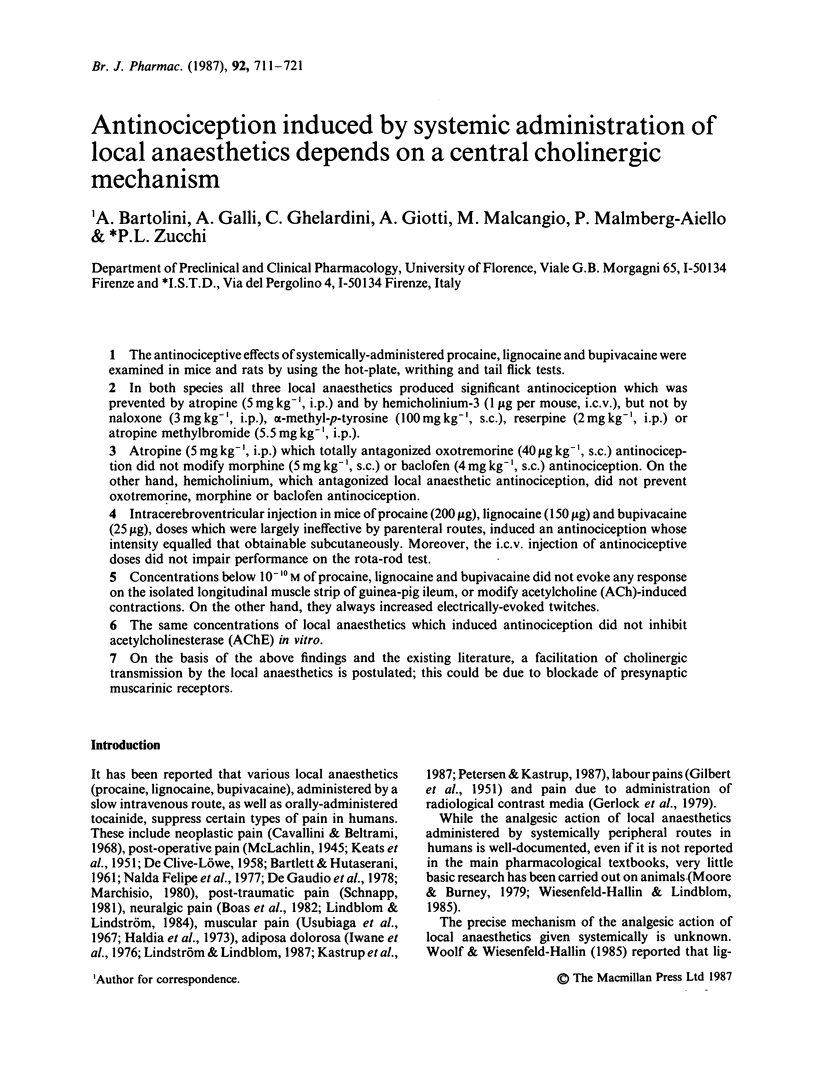
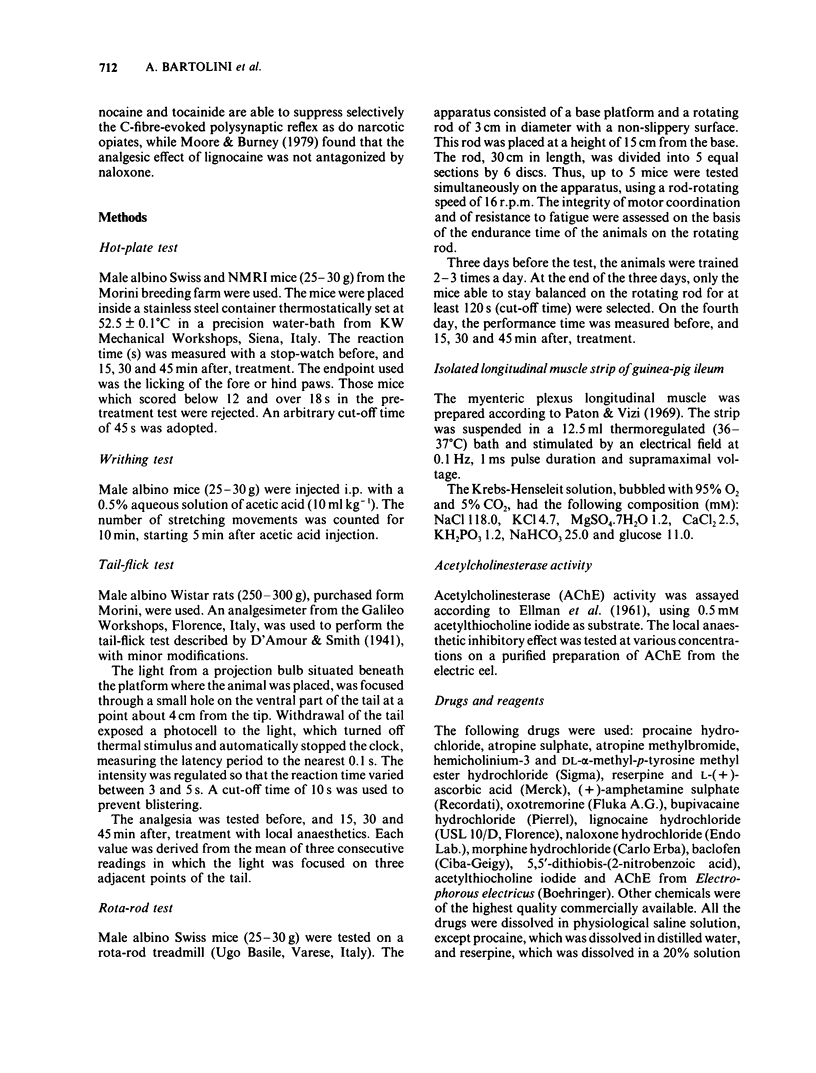
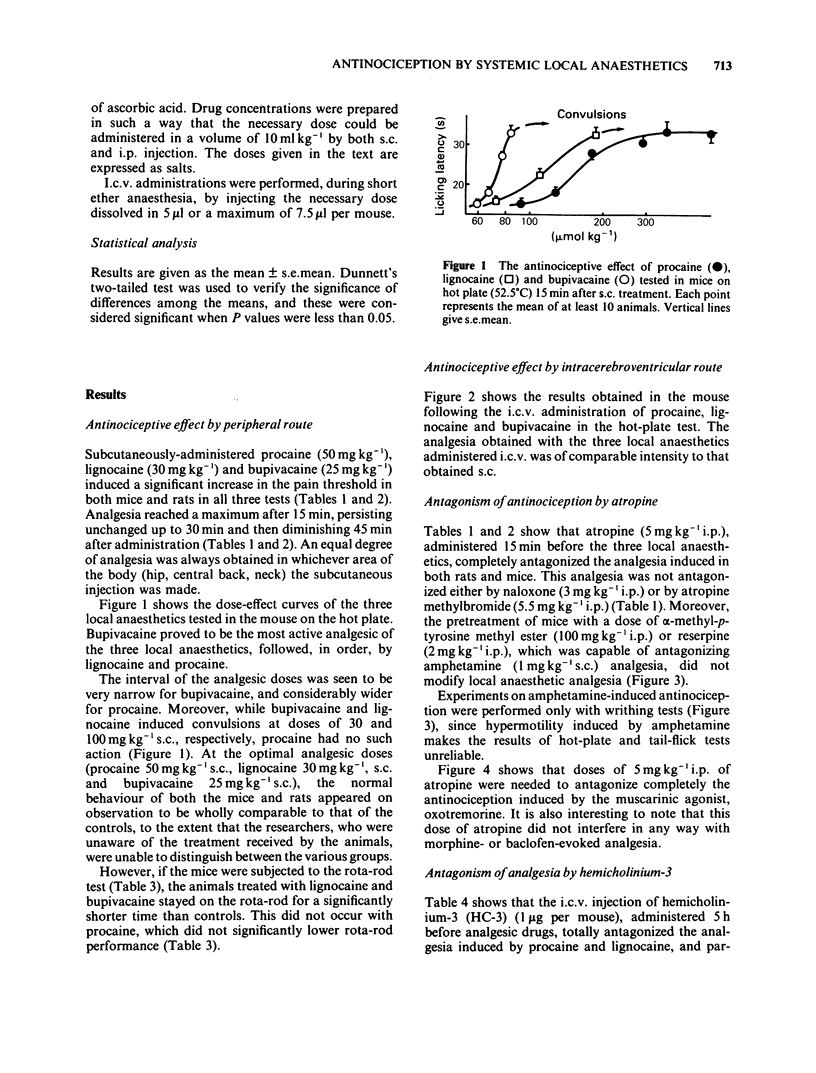
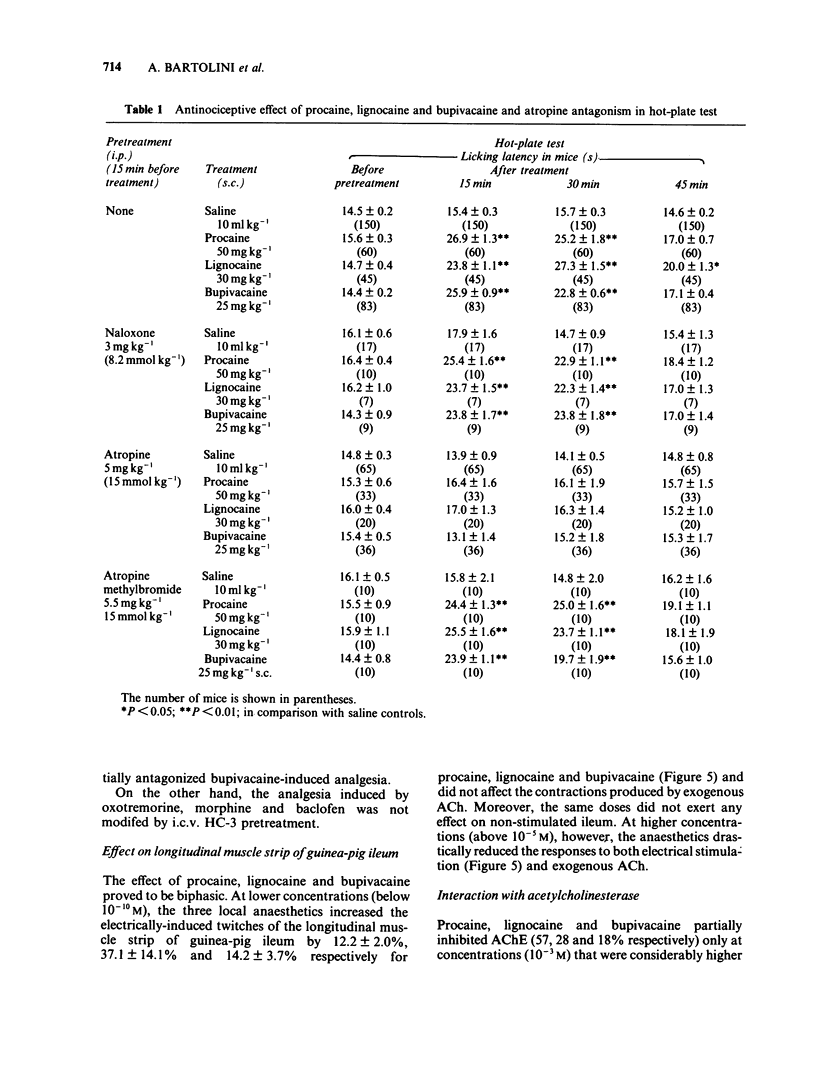
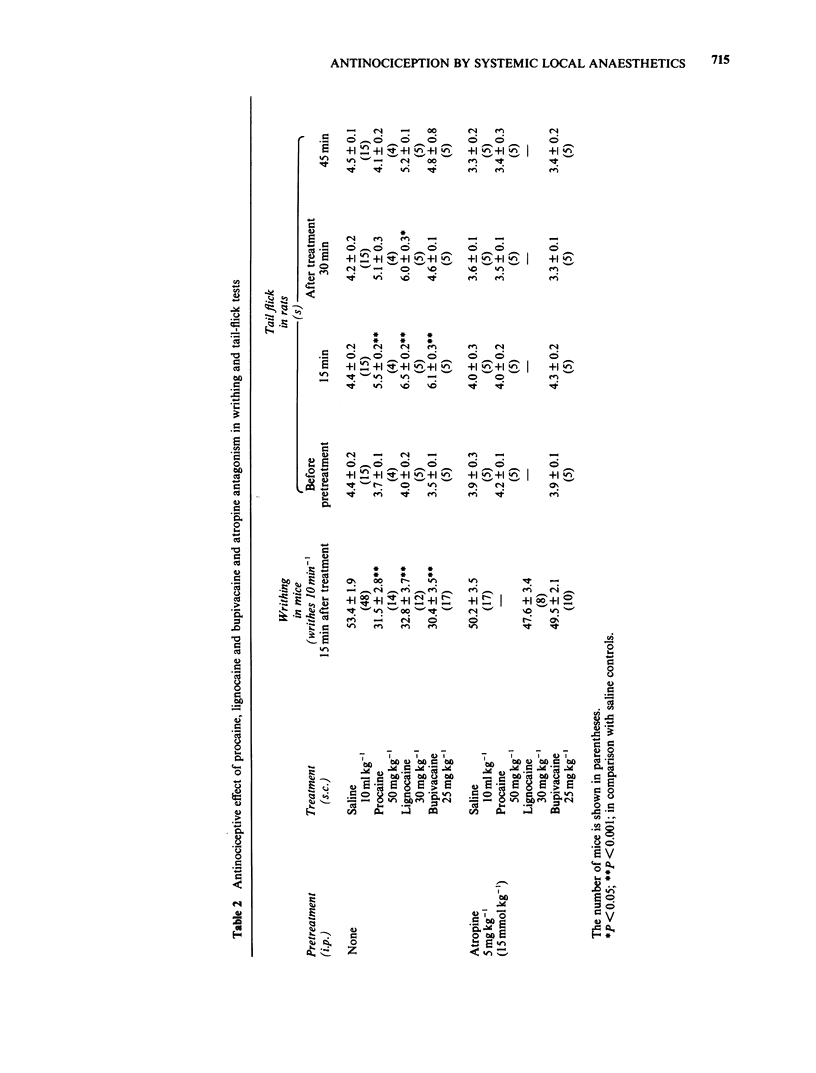
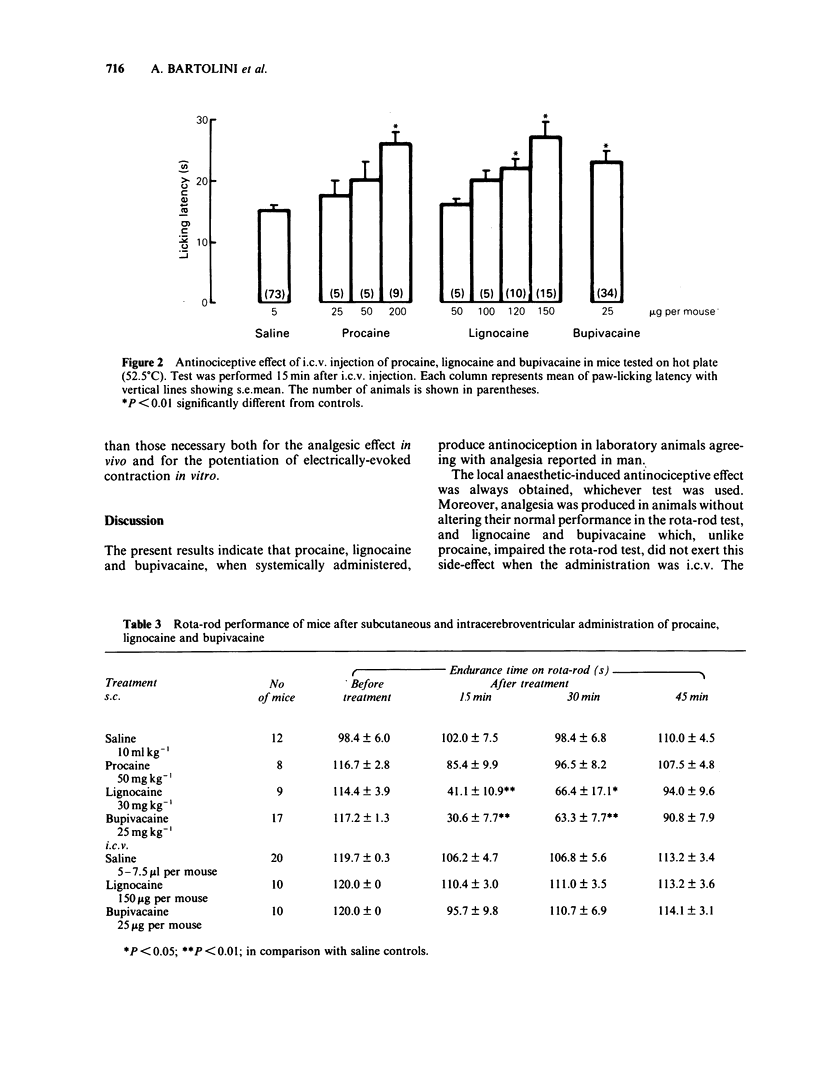
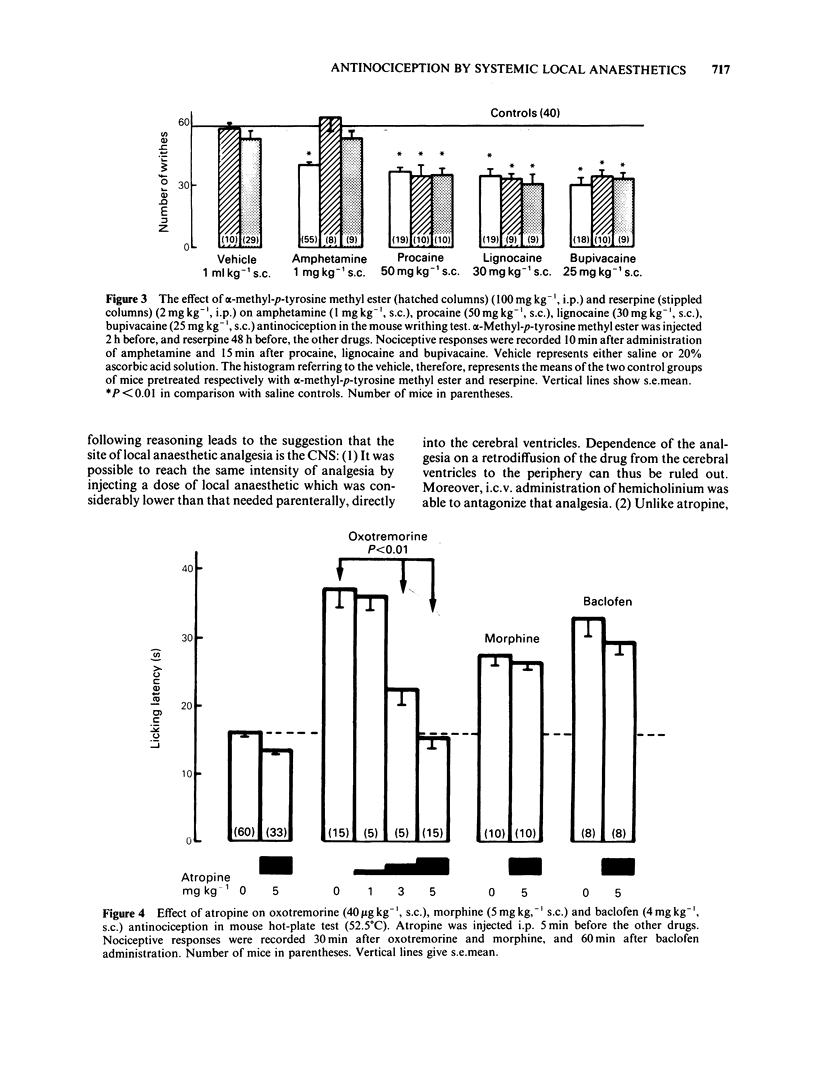
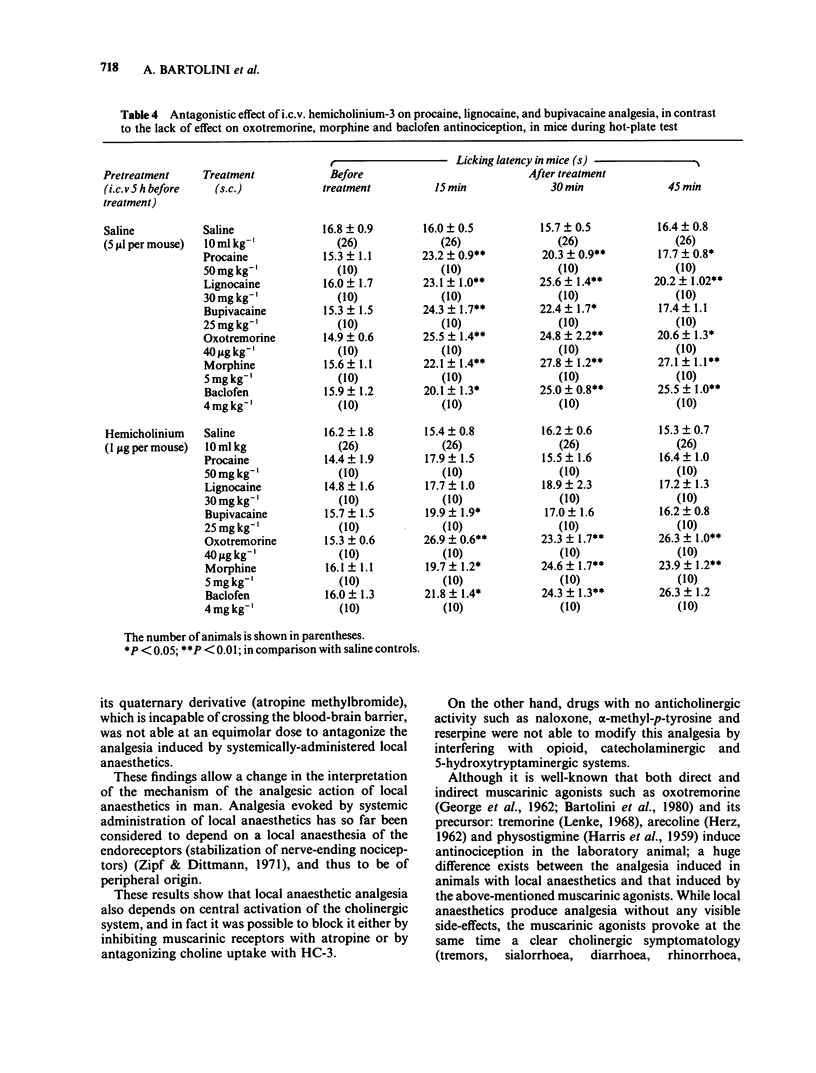
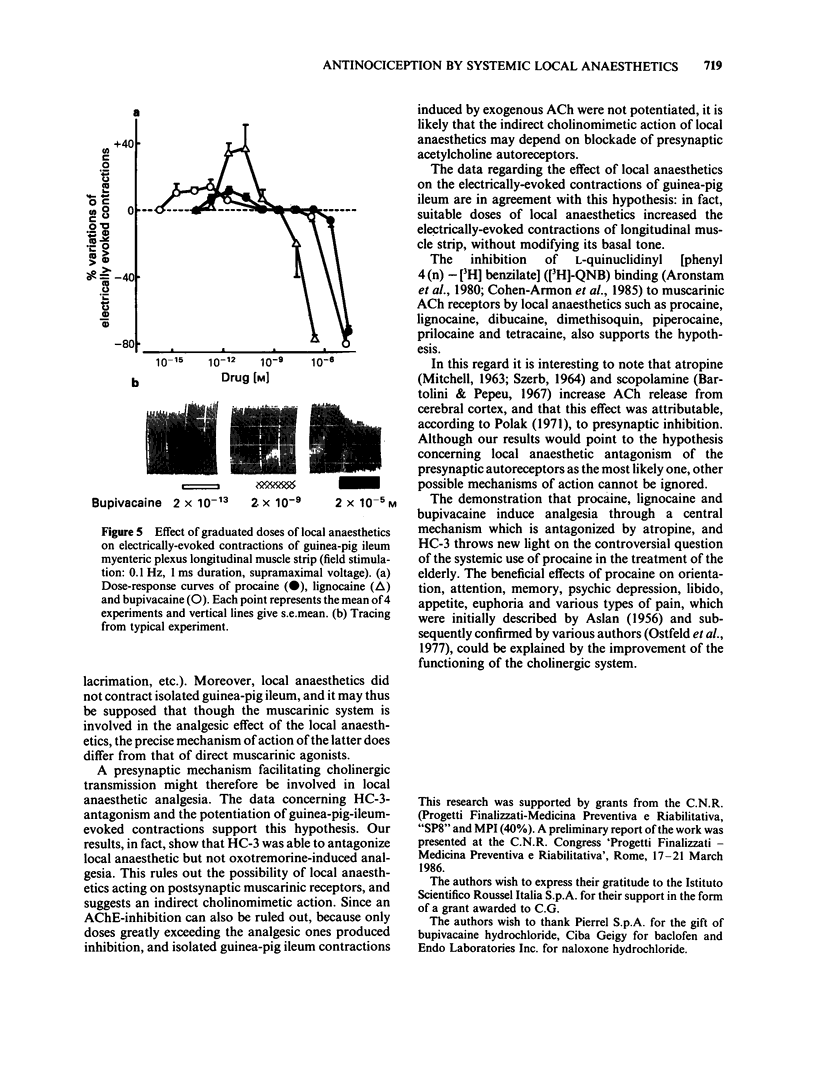
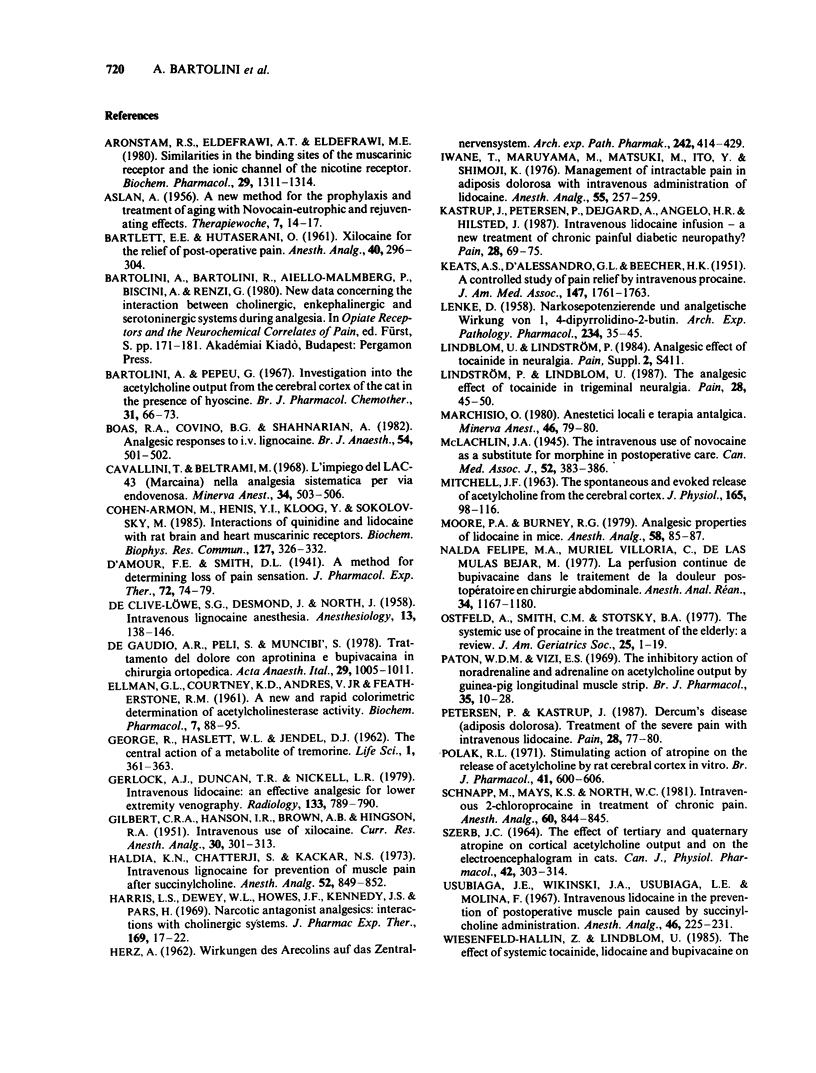
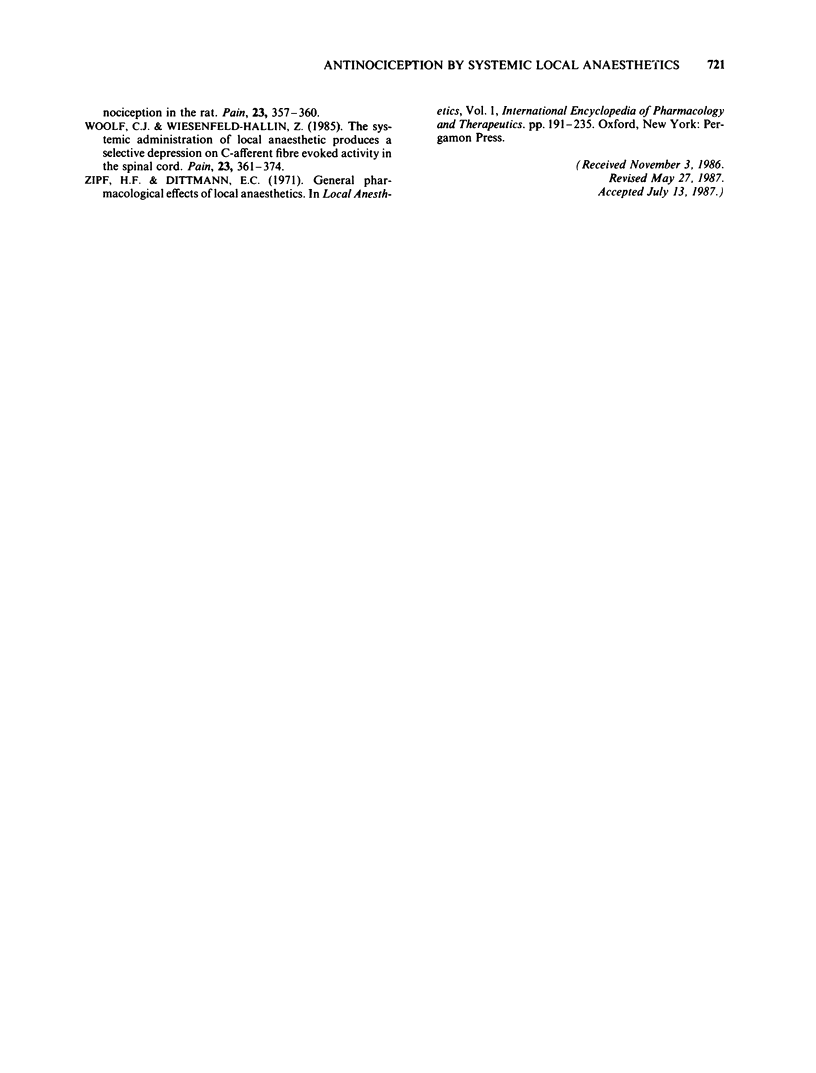
Selected References
These references are in PubMed. This may not be the complete list of references from this article.
- Aronstam R. S., Eldefrawi A. T., Eldefrawi M. E. Similarities in the binding sites of the muscarinic receptor and the ionic channel of the nicotinic receptor. Biochem Pharmacol. 1980 May 1;29(9):1311–1314. doi: 10.1016/0006-2952(80)90292-0. [DOI] [PubMed] [Google Scholar]
- BARTLETT E. E., HUTSERANI O. Xylocaine for the relief of postoperative pain. Anesth Analg. 1961 May-Jun;40:296–304. [PubMed] [Google Scholar]
- Bartolini A., Pepeu G. Investigations into the acetylcholine output from the cerebral cortex of the cat in the presence of hyoscine. Br J Pharmacol Chemother. 1967 Sep;31(1):66–73. doi: 10.1111/j.1476-5381.1967.tb01977.x. [DOI] [PMC free article] [PubMed] [Google Scholar]
- Boas R. A., Covino B. G., Shahnarian A. Analgesic responses to i.v. lignocaine. Br J Anaesth. 1982 May;54(5):501–505. doi: 10.1093/bja/54.5.501. [DOI] [PubMed] [Google Scholar]
- Cavallini T., Beltrami M. L'impiego del LAC-43 (Marcaina) nella analgesia sistematica per via endovenosa. Minerva Anestesiol. 1968 Apr;34(4):503–507. [PubMed] [Google Scholar]
- Cohen-Armon M., Henis Y. I., Kloog Y., Sokolovsky M. Interactions of quinidine and lidocaine with rat brain and heart muscarinic receptors. Biochem Biophys Res Commun. 1985 Feb 28;127(1):326–332. doi: 10.1016/s0006-291x(85)80162-5. [DOI] [PubMed] [Google Scholar]
- DE CLIVE-LOWE S. G., DESMOND J., NORTH J. Intravenous lignocaine anaesthesia. Anaesthesia. 1958 Apr;13(2):138–146. doi: 10.1111/j.1365-2044.1958.tb08045.x. [DOI] [PubMed] [Google Scholar]
- ELLMAN G. L., COURTNEY K. D., ANDRES V., Jr, FEATHER-STONE R. M. A new and rapid colorimetric determination of acetylcholinesterase activity. Biochem Pharmacol. 1961 Jul;7:88–95. doi: 10.1016/0006-2952(61)90145-9. [DOI] [PubMed] [Google Scholar]
- GEORGE R., HASLETT W. L., JENDEN D. J. The central action of a metabolite of tremorine. Life Sci. 1962 Aug;1:361–363. doi: 10.1016/0024-3205(62)90060-7. [DOI] [PubMed] [Google Scholar]
- GILBERT C. R. A., HANSON I. R., BROWN A. B., HINGSON R. A. Intravenous use of xylocaine. Curr Res Anesth Analg. 1951 Nov-Dec;30(6):301–313. [PubMed] [Google Scholar]
- Gerlock A. J., Jr, Duncan T. R., Nickell L. R. Intravenous lidocaine: an effective analgesic for lower extremity venography. Radiology. 1979 Dec;133(3 Pt 1):789–790. doi: 10.1148/133.3.789. [DOI] [PubMed] [Google Scholar]
- HERZ A. [The effects of arecoline on the central nervous system]. Naunyn Schmiedebergs Arch Exp Pathol Pharmakol. 1962;242:414–429. [PubMed] [Google Scholar]
- Haldia K. N., Chatterji S., Kackar S. N. Intravenous lignocaine for prevention of muscle pain after succinylcholine. Anesth Analg. 1973 Sep-Oct;52(5):849–852. [PubMed] [Google Scholar]
- Harris L. S., Dewey W. L., Howes J. F., Kennedy J. S., Pars H. Narcotic-antagonist analgesics: interactions with cholinergic systems. J Pharmacol Exp Ther. 1969 Sep;169(1):17–22. [PubMed] [Google Scholar]
- Iwane T., Maruyama M., Matsuki M., Ito Y., Shimoji K. Management of intractable pain in adiposis dolorosa with intravenous administration of lidocaine. Anesth Analg. 1976 Mar-Apr;55(2):257–259. doi: 10.1213/00000539-197603000-00028. [DOI] [PubMed] [Google Scholar]
- KEATS A. S., D'ALESSANDRO G. L., BEECHER H. K. Controlled study of pain relief by intravenous procaine. J Am Med Assoc. 1951 Dec 29;147(18):1761–1763. doi: 10.1001/jama.1951.73670350005011. [DOI] [PubMed] [Google Scholar]
- Kastrup J., Petersen P., Dejgård A., Angelo H. R., Hilsted J. Intravenous lidocaine infusion--a new treatment of chronic painful diabetic neuropathy? Pain. 1987 Jan;28(1):69–75. doi: 10.1016/0304-3959(87)91061-X. [DOI] [PubMed] [Google Scholar]
- LENKE D. Narkosepotenzierende und analgetische Wirkung von 1,4-Dipyrrolidino-2-butin. Naunyn Schmiedebergs Arch Exp Pathol Pharmakol. 1958;234(1):35–45. [PubMed] [Google Scholar]
- Lindström P., Lindblom U. The analgesic effect of tocainide in trigeminal neuralgia. Pain. 1987 Jan;28(1):45–50. doi: 10.1016/0304-3959(87)91058-X. [DOI] [PubMed] [Google Scholar]
- Marchisio O. Anestetici locali e terapia antalgica. Minerva Anestesiol. 1980 Jan;46(1):79–80. [PubMed] [Google Scholar]
- McLachlin J. A. The Intravenous Use of Novocaine as a Substitute for Morphine in Postoperative Care. Can Med Assoc J. 1945 Apr;52(4):383–386. [PMC free article] [PubMed] [Google Scholar]
- Mitchell J. F. The spontaneous and evoked release of acetylcholine from the cerebral cortex. J Physiol. 1963 Jan;165(1):98–116. doi: 10.1113/jphysiol.1963.sp007045. [DOI] [PMC free article] [PubMed] [Google Scholar]
- Moore P. A., Burney R. G. Analgesic properties of lidocaine in mice. Anesth Analg. 1979 Mar-Apr;58(2):85–87. [PubMed] [Google Scholar]
- Nalda Felipe M. A., Muriel Villoria C., de las Mulas Bejar M. La perfusion continue de bupivacaine dans le traitement de la douleur postopératoire en chirurgie abdominale. Anesth Analg (Paris) 1977 Nov-Dec;34(6):1167–1180. [PubMed] [Google Scholar]
- Ostfeld A., Smith C. M., Stotsky B. A. The systemic use of procaine in the treatment of the elderly: a review. J Am Geriatr Soc. 1977 Jan;25(1):1–19. doi: 10.1111/j.1532-5415.1977.tb00917.x. [DOI] [PubMed] [Google Scholar]
- Paton W. D., Vizi E. S. The inhibitory action of noradrenaline and adrenaline on acetylcholine output by guinea-pig ileum longitudinal muscle strip. Br J Pharmacol. 1969 Jan;35(1):10–28. doi: 10.1111/j.1476-5381.1969.tb07964.x. [DOI] [PMC free article] [PubMed] [Google Scholar]
- Petersen P., Kastrup J. Dercum's disease (adiposis dolorosa). Treatment of the severe pain with intravenous lidocaine. Pain. 1987 Jan;28(1):77–80. doi: 10.1016/0304-3959(87)91062-1. [DOI] [PubMed] [Google Scholar]
- Polak R. L. Stimulating action of atropine on the release of acetylcholine by rat cerebral cortex in vitro. Br J Pharmacol. 1971 Apr;41(4):600–606. doi: 10.1111/j.1476-5381.1971.tb07068.x. [DOI] [PMC free article] [PubMed] [Google Scholar]
- SZERB J. THE EFFECT OF TERTIARY AND QUATERNARY ATROPINE ON CORTICAL ACETYLCHOLINE OUTPUT AND ON THE ELECTROENCEPHALOGRAM IN CATS. Can J Physiol Pharmacol. 1964 May;42:303–314. doi: 10.1139/y64-036. [DOI] [PubMed] [Google Scholar]
- Schnapp M., Mays K. S., North W. C. Intravenous 2-chloroprocaine in treatment of chronic pain. Anesth Analg. 1981 Nov;60(11):844–845. [PubMed] [Google Scholar]
- Usubiaga J. E., Wikinski J. A., Usubiaga L. E., Molina F. Intravenous lidocaine in the prevention of postoperative muscle pain caused by succinylcholine administration. Anesth Analg. 1967 Mar-Apr;46(2):225–230. [PubMed] [Google Scholar]
- Wiesenfeld-Hallin Z., Lindblom U. The effect of systemic tocainide, lidocaine and bupivacaine on nociception in the rat. Pain. 1985 Dec;23(4):357–360. doi: 10.1016/0304-3959(85)90005-3. [DOI] [PubMed] [Google Scholar]
- Woolf C. J., Wiesenfeld-Hallin Z. The systemic administration of local anaesthetics produces a selective depression of C-afferent fibre evoked activity in the spinal cord. Pain. 1985 Dec;23(4):361–374. doi: 10.1016/0304-3959(85)90006-5. [DOI] [PubMed] [Google Scholar]


